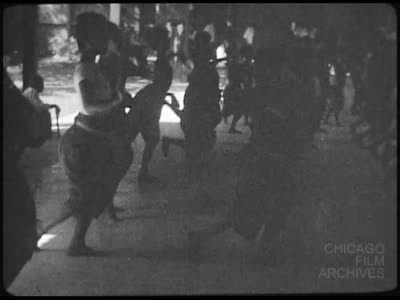Cambodian Royal Dancers [1928, Phnom Penh]
Identifier
F.2011-05-0067
Date Of Production
1928
Abstract
This film represents a demonstration of Khmer classical dances by Cambodian royal court dancers. It was filmed during Ruth Page's tour of Southeast Asia in 1928; this reel in particular is labeled December 12, 1928. It was filmed in low light so the movements are often hard to make out; the original container notes suggest the demonstration may have taken place at a museum.
Description
The film begins with a shot of several long rows of dancers, all barefoot and wearing a dark uniform with belt and harem-type pants. They are standing in a covered outdoor hallway of sorts, performing a slow, intricate dance. Almost immediately, the film cuts forward to a segment in which the dancers sit on their knees and perform articulations of their hands and upper bodies, occasionally bobbing slightly up and down. After another cut, they demonstrate slowly changing the positions of the legs to stand up fluidly. They then stand in a position not unlike western ballet's first position, with a plié.
At this point, there is a brief intercutting of different footage: the camera appears to be pointed toward a break in a fence, where a young girl passes by.
The film then returns to the hallway, where the dancers demonstrate more arm positions and pliés in unison. Other people walk through and around the dancing area, with some watching on the sides; the camera sometimes strays to focus on them. The dancers themselves frequently balance on one leg, with the other foot flexed, while continuing to plié and articulate their arms. They sometimes swivel as a group to face a different direction for some portions of the dance.
There is a long pause in the middle of the film: handwriting on the celluloid flashes by. When the film returns to the demonstration in Phnom Penh, the images are difficult to make out at first, but when the film becomes clear again, the dancers begin to run around the space in a snake-like loop. As they run past, it becomes clear that the demonstration includes dancers ranging in age from toddlers to young adults. The camera captures this graceful scurry and its arm positions from several angles before the dancers briefly stop (once again in rows), perform a few movements, and begin looping around again. This final snake then dissolves and the dancers begin to scatter.
The film then cuts to a shot of Ruth Page sitting in the grass, with a sketchbook, beside some locals. The camera pans right and tilts up to reveal an older man (her father?) with a cane standing next to them.
Once again, the film cuts back to the dancers in the hallway. All now hold a short ceremonial stick that is balanced as part of the dance. Some of Page's party is also visible, watching on the side. The film ends while the dancers are still demonstrating with the sticks.
At this point, there is a brief intercutting of different footage: the camera appears to be pointed toward a break in a fence, where a young girl passes by.
The film then returns to the hallway, where the dancers demonstrate more arm positions and pliés in unison. Other people walk through and around the dancing area, with some watching on the sides; the camera sometimes strays to focus on them. The dancers themselves frequently balance on one leg, with the other foot flexed, while continuing to plié and articulate their arms. They sometimes swivel as a group to face a different direction for some portions of the dance.
There is a long pause in the middle of the film: handwriting on the celluloid flashes by. When the film returns to the demonstration in Phnom Penh, the images are difficult to make out at first, but when the film becomes clear again, the dancers begin to run around the space in a snake-like loop. As they run past, it becomes clear that the demonstration includes dancers ranging in age from toddlers to young adults. The camera captures this graceful scurry and its arm positions from several angles before the dancers briefly stop (once again in rows), perform a few movements, and begin looping around again. This final snake then dissolves and the dancers begin to scatter.
The film then cuts to a shot of Ruth Page sitting in the grass, with a sketchbook, beside some locals. The camera pans right and tilts up to reveal an older man (her father?) with a cane standing next to them.
Once again, the film cuts back to the dancers in the hallway. All now hold a short ceremonial stick that is balanced as part of the dance. Some of Page's party is also visible, watching on the side. The film ends while the dancers are still demonstrating with the sticks.
Run Time
9 min 5 sec
Format
16mm
Extent
100 feet
Color
B&W
Sound
Silent
Reel/Tape Number
1/1
Has Been Digitized?
Yes
Language Of Materials
English
Element
Reversal Positives
Genre
Form
Subject
Related Collections
Related Places
Do you know more about this item?
If you have more information about this item please contact us at info@chicagofilmarchives.com.



